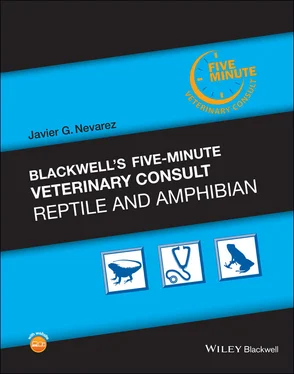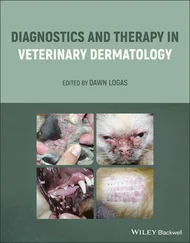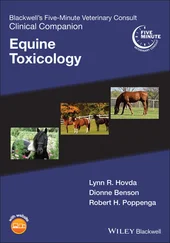Change in diet
Poor sanitation can lead to high endoparasite load due to the direct lifecycle of many intestinal parasites of chelonians.
Overcrowding results in stress
Inappropriate (too low or too high) environmental temperatures.
Wild‐caught animals often have a high endoparasite load and are often stressed during acclimatization to captivity.
Lack of fecal parasitology screening after acquisition.
 DIAGNOSIS
DIAGNOSIS
DIFFERENTIAL DIAGNOSIS
Enteritis - bacterial, parasitic, dietary DIAGNOSTICS
Fecal direct wet mount to evaluate for motile protozoa.
Fecal flotation to evaluate for helminths and protozoa (e.g., amoeba cysts).
Fecal cytology to rule out fungal infections
Diagnostic imaging (radiographs, CT, ultrasound) as needed.
Fecal bacterial cultures are rarely useful in the diagnosis and treatment of chelonians with diarrhea.
Enteritis
Malodorous and liquid intestinal content
Emaciation
 TREATMENT
TREATMENT
APPROPRIATE HEALTH CARE
N/A
Correct diet to ensure sufficient fiber intake in herbivorous tortoises.
Provide nutritional support to emaciated and/or anorexic animals.
Provide fluid therapy to dehydrated animals.
CLIENT EDUCATION/HUSBANDRY RECOMMENDATIONS
N/A
 MEDICATIONS
MEDICATIONS
DRUG(S) OF CHOICE
Metronidazole: 40–100 mg/kg PO repeat 10–14 days or 25 mg/kg PO q24h for 5 days. Effective against motile protozoal organisms.
Emodepside/praziquantel (Profender®, Bayer DVM, Pittsburgh, PA): 1 ml/kg topical on skin. Repeat after 14 days. Effective against nematodes, trematodes and cestodes. Recommended in particular in animals that cannot be dosed orally. Animals should not be soaked for 24 hours after topical administration. Apply to skin around forelimbs and neck.
Fenbendazole: 20 mg/kg PO q24h for 3–5 days. Effective against nematodes and flagellates.
Pyrantel pamoate: 25 mg/kg PO q24h for 5 days, repeat in 3 weeks. Effective against nematodes including pinworms and ascarids.
Keep on newspaper until treatment is completed and recheck fecal samples.
Immediate removal of feces to prevent ingestion, bathing the tortoises, and cleaning of the pericloacal region to remove feces and eggs or cysts are strongly recommended.
Prevention of reinfection is critically important during and following treatment against parasites with a direct lifecycle.
Fenbendazole has been shown to result in heteropenia and biochemical abnormalities in Testudo hermanni following administration of two courses of 50 mg/kg q24h for 5 days.
Fenbendazole has been shown in other reptiles to cause bone marrow suppression and temporary pancytopenia. Avoid doses > 20 mg/kg.
Do not use ivermectin or other macrocyclic lactones (e.g., selamectin) in chelonians.
 FOLLOW‐UP
FOLLOW‐UP
PATIENT MONITORING
Return to normal fecal consistency.
Weight gain and maintenance of hydration.
Repeat fecal exams to ensure treatment effectiveness.
EXPECTED COURSE AND PROGNOSIS
If dietary causes are responsible for the diarrhea, then prognosis is good to excellent.
Animals in good body condition with no concurrent morbidities have a good to excellent prognosis.
Animals in poor body condition with signs of systemic illness (dehydration, lethargy, etc.) have a guarded to poor prognosis.
 MISCELLANEOUS
MISCELLANEOUS
COMMENTS
Diarrhea is a clinical sign associated with an underlying diseases, improper husbandry, or nutrition.
Identification of the underlying cause is necessary to improve outcome and reduce the risk of reoccurrence.
Correction of husbandry is always recommended to in help improve the outcome.
Salmonella spp. are commonly shed from chelonians with and without diarrhea.
N/A
CT = computed tomography
PO = per os
1 Funk RS. Diarrhea. In: Mader DR, ed. Reptile Medicine and Surgery. 2nd ed. St. Louis, MO: Elsevier Saunders; 2006:772–773.
2 Greiner EC, Mader DR. Parasitology. In: Mader DR, ed. Reptile Medicine and Surgery. 2nd ed. St. Louis, MO: Elsevier Saunders; 2006:343–364.
AuthorChristoph Mans, Dr. med. vet., DACZM
Dystocia
 BASICS
BASICS
DEFINITION/OVERVIEW
Dystocia is difficulty laying eggs.
The reproductive hormone mechanism in reptiles is not as well understood as that of mammals.
It is suspected that a multitude of environmental and behavioral factors, as well as underlying diseases, contribute to an abnormal function of the endocrine system, which in turn leads to dystocia.
It is also possible that a lack of breeding and exposure to males may be contributing factors.
In addition to basic husbandry aspects, such as UVB light, temperature, humidity, and a proper diet, female reptiles also have a need for appropriate substrate and environment that is conductive for egg laying.
Dystocia occurs in female chelonians of reproductive age or size.
Most animals have a history of inadequate nutrition and husbandry lacking an appropriate area for laying eggs.
Signs of dystocia may include straining with or without vocalization, decreased fecal production, cloacal prolapse, hind limb weakness/paresis, lethargy, and anorexia.
Some animals may also appear restless and may be observed attempting to dig.
In some instances, the eggs may be palpable through the prefemoral fossa during physical exam.
Physical exam should be done carefully to avoid rupturing the eggs.
In most cases, the owners are not aware of the fact that their chelonian is in dystocia.
Other abnormalities identified in physical exam may include dehydration, poor body condition score, and pliable bones.
Inappropriate husbandry is likely a significant contributing factor to the occurrence of dystocia.
Читать дальше

 DIAGNOSIS
DIAGNOSIS TREATMENT
TREATMENT MEDICATIONS
MEDICATIONS FOLLOW‐UP
FOLLOW‐UP MISCELLANEOUS
MISCELLANEOUS BASICS
BASICS










